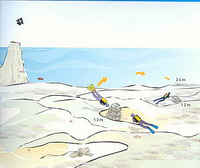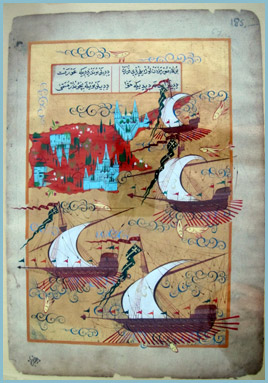
This was an unexpected discovery and is still a work in progress. We will have to complete much more research to definitively identify the aircraft and determine why the crash occured. We had heard rumours of a plane wreck off shore near the Kyrenia Power Station. Locating the wreck was another matter - the sea always hides her mysteries very well. Thanks to the asistance of Mr. İsmail Kırmızı and Mr. Serdar Denktaş, we were able to locate many pieces of the wreck. Indeed we were fortunate to have both of these individuals accompany us to initially explore the wreck site.
This is a relatively easy dive and the maximum depth is approximately 24 meters. The only caution would be to watch your air supply - we were so fascinated with the wreck that we had our longest dive on Cyprus - a full eighty minutes!
The GPS waypoints will position you about one mile off shore from Esentepe. As you enter the water, drop down to the bottom where you will be in the midst of a large field of neptune grass. If you fin about thirty meters to the east you should see two large aircraft engines lying in the sand. The engines are some distance apart - perhaps 20 meters. They are also partially obscured by the neptune grass. As you explore the engines, notice the serial numbers on several different component parts.
We were not able to observe the engine serial number or the name of the manufacturer. The engines are large and appear to be of the high horsepower radial design required for a bomber type of aircraft. There was considerable activity in this area during World War II but it is really impossible at the moment to even date the aircraft. We also do know that the British had a squadron of Wellington long-range bomber aircraft stationed in Malta.
The Wellingtons were eventually replaced by the smaller three person Mark IV Blenheim bombers which did indeed have large high horsepower radial engines manufactured by Bristol Mercury in the UK.
If you fin a little further beyond the engines, you will come to the debris of what appears to have been the cockpit. It is not complete so you will have to use your imagination with the various bits and pieces scattered about. We did locate a gun and a radio among the cockpit debris. It would also appear that the crew of the aircraft were able to exit prior to or shortly after the crash occured. There is no indication of their presence at the wreck site.
If you return to the point at which your dive began, gin about 50 meters beyond. You will see manu smaller pieces of the wreck buried in the sand and well hidden by the forest of neptune grass. If you come up a little to say 15 meters and face east you can almost visualize the crash site.The site appears to be at least a 300 meter swat across the sea bottom. This wreck site requires an active imagination as it is literally a series of small and large pieces of debris - much of which is difficult to identify.
We have provided the serial numbers that we recorded from several parts and a series of photographs to the British, Turkish and northern Cypriot authorities. So far the plane wreck continues to be a mystery. If you should dive the plane wreck and observe any markings or characteristics that would assist in identifying the wreck, please do let us know. We in turn would be delighted to keep you posted on any new developments. |

